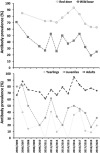Determinants of Crimean-Congo haemorrhagic fever virus exposure dynamics in Mediterranean environments
- PMID: 36183164
- PMCID: PMC10092370
- DOI: 10.1111/tbed.14720
Determinants of Crimean-Congo haemorrhagic fever virus exposure dynamics in Mediterranean environments
Abstract
Crimean-Congo haemorrhagic fever (CCHF) is an emerging tick-borne human disease in Spain. Understanding the spatiotemporal dynamics and exposure risk determinants of CCHF virus (CCHFV) in animal models is essential to predict the time and areas of highest transmission risk. With this goal, we designed a longitudinal survey of two wild ungulate species, the red deer (Cervus elaphus) and the Eurasian wild boar (Sus scrofa), in Doñana National Park, a protected Mediterranean biodiversity hotspot with high ungulate and CCHFV vector abundance, and which is also one of the main stopover sites for migratory birds between Africa and western Europe. Both ungulates are hosts to the principal CCHFV vector in Spain, Hyalomma lusitanicum. We sampled wild ungulates annually from 2005 to 2020 and analysed the frequency of exposure to CCHFV by a double-antigen ELISA. The annual exposure risk was modelled as a function of environmental traits in an approach to understanding exposure risk determinants that allow us to predict the most likely places and years for CCHFV transmission. The main findings show that H. lusitanicum abundance is a fundamental driver of the fine-scale spatial CCHFV transmission risk, while inter-annual risk variation is conditioned by virus/vector hosts, host community structure and weather variations. The most relevant conclusion of the study is that the emergence of CCHF in Spain might be associated with recent wild ungulate population changes promoting higher vector abundance. This work provides relevant insights into the transmission dynamics of CCHFV in enzootic scenarios that would allow deepening the understanding of the ecology of CCHFV and its major determinants.
Keywords: disease ecology; host-tick-pathogen interactions; tick; wild ungulates; zoonosis.
© 2022 The Authors. Transboundary and Emerging Diseases published by Wiley-VCH GmbH.
Conflict of interest statement
The authors declare no conflict of interest.
Figures



Similar articles
-
Detection of new Crimean-Congo haemorrhagic fever virus genotypes in ticks feeding on deer and wild boar, Spain.Transbound Emerg Dis. 2021 May;68(3):993-1000. doi: 10.1111/tbed.13756. Epub 2020 Aug 11. Transbound Emerg Dis. 2021. PMID: 32738065
-
Red deer reveal spatial risks of Crimean-Congo haemorrhagic fever virus infection.Transbound Emerg Dis. 2022 Jul;69(4):e630-e645. doi: 10.1111/tbed.14385. Epub 2021 Nov 19. Transbound Emerg Dis. 2022. PMID: 34739746
-
Mapping the risk of exposure to Crimean-Congo haemorrhagic fever virus in the Iberian Peninsula using Eurasian wild boar (Sus scrofa) as a model.Ticks Tick Borne Dis. 2024 Jan;15(1):102281. doi: 10.1016/j.ttbdis.2023.102281. Epub 2023 Nov 22. Ticks Tick Borne Dis. 2024. PMID: 37995393
-
Epidemiological Aspects of Crimean-Congo Hemorrhagic Fever in Western Europe: What about the Future?Microorganisms. 2021 Mar 21;9(3):649. doi: 10.3390/microorganisms9030649. Microorganisms. 2021. PMID: 33801015 Free PMC article. Review.
-
The feasibility of developing a risk assessment for the impact of climate change on the emergence of Crimean-Congo haemorrhagic fever in livestock in Europe: a review.J Appl Microbiol. 2010 Jun;108(6):1859-70. doi: 10.1111/j.1365-2672.2009.04638.x. Epub 2009 Nov 28. J Appl Microbiol. 2010. PMID: 20015209 Review.
Cited by
-
Epidemiologic Survey of Crimean-Congo Hemorrhagic Fever Virus in Suids, Spain.Emerg Infect Dis. 2024 May;30(5):984-990. doi: 10.3201/eid3005.240074. Emerg Infect Dis. 2024. PMID: 38666621 Free PMC article.
-
Insights into the spatiotemporal dynamics of West Nile virus transmission in emerging scenarios.One Health. 2023 May 1;16:100557. doi: 10.1016/j.onehlt.2023.100557. eCollection 2023 Jun. One Health. 2023. PMID: 37363231 Free PMC article.
-
Animal Exposure Model for Mapping Crimean-Congo Hemorrhagic Fever Virus Emergence Risk.Emerg Infect Dis. 2024 Apr;30(4):672-680. doi: 10.3201/eid3004.221604. Emerg Infect Dis. 2024. PMID: 38526057 Free PMC article.
-
Evidence of Crimean-Congo hemorrhagic fever virus in livestock and wildlife in Northeastern Portugal.Sci Rep. 2025 Jul 11;15(1):25142. doi: 10.1038/s41598-025-10627-5. Sci Rep. 2025. PMID: 40646032 Free PMC article.
-
Dynamics of Crimean-Congo hemorrhagic fever virus in two wild ungulate hosts during a disease-induced population collapse.One Health. 2023 Aug 23;17:100622. doi: 10.1016/j.onehlt.2023.100622. eCollection 2023 Dec. One Health. 2023. PMID: 38024274 Free PMC article.
References
-
- Acevedo, P. , Ruiz‐Fons, F. , Estrada, R. , Márquez, A. L. , Miranda, M. A. , Gortázar, C. , & Lucientes, J. (2010). A broad assessment of factors determining Culicoides imicola abundance: Modelling the present and forecasting its future in climate change scenarios. PLoS ONE, 5, e14236. 10.1371/journal.pone.0014236 - DOI - PMC - PubMed
-
- Bah, M. T. , Grosbois, V. , Stachurski, F. , Muñoz, F. , Duhayon, M. , Rakotoarivony, I. , Appelgren, A. , Calloix, C. , Noguera, L. , Mouillaud, T. , Andary, C. , Lancelot, R. , Huber, K. , Garros, C. , Leblond, A. , & Vial, L. (2022). The Crimean‐Congo haemorrhagic fever tick vector Hyalomma marginatum in the south of France: Modelling its distribution and determination of factors influencing its establishment in a newly invaded area. Transboundary and Emerging Diseases, 69(5), e2351–e2365. 10.1111/tbed.14578 - DOI - PMC - PubMed
-
- Barandika, J. F. , Olmeda, S. A. , Casado‐Nistal, M. A. , Hurtado, A. , Juste, R. A. , Valcárcel, F. , Anda, P. , & García‐Pérez, A. L. (2011). Differences in questing tick species distribution between Atlantic and continental climate regions in Spain. Journal of Medical Entomology, 48, 13–19. 10.1603/me10079 - DOI - PubMed
-
- Barasona, J. A. , Latham, M. C. , Acevedo, P. , Armenteros, J. A. , Latham, A. D. , Gortazar, C. , Carro, F. , Soriguer, R. C. , & Vicente, J. (2014). Spatiotemporal interactions between wild boar and cattle: Implications for cross‐species disease transmission. Veterinary Research, 45, 122. 10.1186/s13567-014-0122-7 - DOI - PMC - PubMed
MeSH terms
Grants and funding
LinkOut - more resources
Full Text Sources

